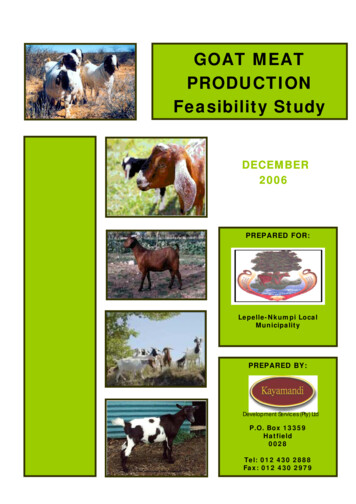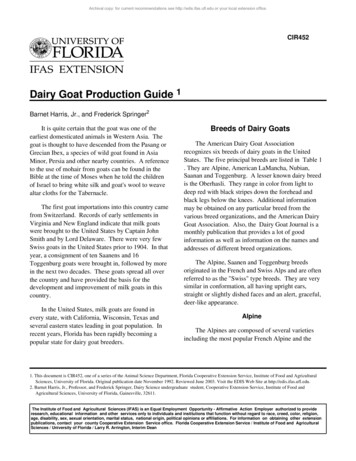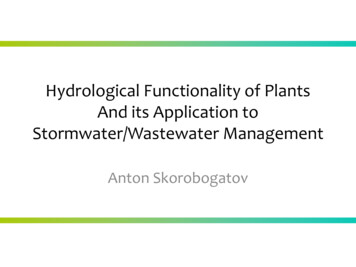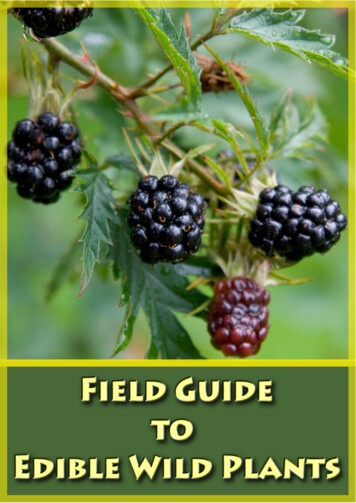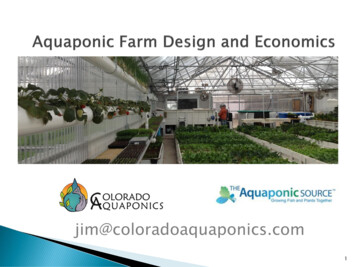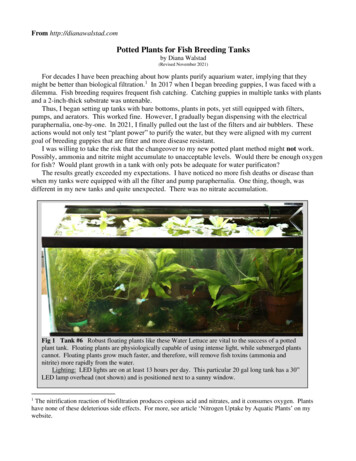
Transcription
From http://dianawalstad.comPotted Plants for Fish Breeding Tanksby Diana Walstad(Revised November 2021)For decades I have been preaching about how plants purify aquarium water, implying that theymight be better than biological filtration.1 In 2017 when I began breeding guppies, I was faced with adilemma. Fish breeding requires frequent fish catching. Catching guppies in multiple tanks with plantsand a 2-inch-thick substrate was untenable.Thus, I began setting up tanks with bare bottoms, plants in pots, yet still equipped with filters,pumps, and aerators. This worked fine. However, I gradually began dispensing with the electricalparaphernalia, one-by-one. In 2021, I finally pulled out the last of the filters and air bubblers. Theseactions would not only test “plant power” to purify the water, but they were aligned with my currentgoal of breeding guppies that are fitter and more disease resistant.I was willing to take the risk that the changeover to my new potted plant method might not work.Possibly, ammonia and nitrite might accumulate to unacceptable levels. Would there be enough oxygenfor fish? Would plant growth in a tank with only pots be adequate for water purificaton?The results greatly exceeded my expectations. I have noticed no more fish deaths or disease thanwhen my tanks were equipped with all the filter and pump paraphernalia. One thing, though, wasdifferent in my new tanks and quite unexpected. There was no nitrate accumulation.Fig 1 Tank #6 Robust floating plants like these Water Lettuce are vital to the success of a pottedplant tank. Floating plants are physiologically capable of using intense light, while submerged plantscannot. Floating plants grow much faster, and therefore, will remove fish toxins (ammonia andnitrite) more rapidly from the water.Lighting: LED lights are on at least 13 hours per day. This particular 20 gal long tank has a 30”LED lamp overhead (not shown) and is positioned next to a sunny window.1The nitrification reaction of biofiltration produces copious acid and nitrates, and it consumes oxygen. Plantshave none of these deleterious side effects. For more, see article ‘Nitrogen Uptake by Aquatic Plants’ on mywebsite.
2Fig 2 Tank #8 (a 5 gal) was aFig 3 Tank #7 This 20 gal long gets LED light plus window light.temporary outdoor tank that I used foroutcrossing two populations of RCS(Red Cherry Shrimp).Bio-load in this tank is typical--about 40 adult guppies (1” long)and 30-40 Neocaridina shrimp. In the 10 gal tanks, I routinely keepabout half this number of animals.Figs 1-5 show the 10 tanks that Ibase this article on. Every tank isdifferent, so the consistency of myresults is noteworthy. My pottedplant system is not just a “one tankwonder.”The tanks were originally set upfor guppy breeding, but along theway I started raising Neocaridinashrimp with the guppies. These littleinvertebrate cuties are just as hard tocatch as guppies, but my new tanksmake managing their populationdoable. Potted plants allow me tocombine fish, plants and shrimp all inone tank!Fig 4 Tank #9 This 20 gal long that I kept outside over thesummer received mostly shade light. The water temperature remainedrelatively cool (65-75 F). Plants and fish did okay, but unlike myother 9 tanks, this tank accumulated nitrates. After I brought the tankindoors where it had light and temperatures comparable to the othertanks, nitrates no longer accumulated.Fig 5 Tanks #3, and 4 A 36” lamp spans these two 10 gal tanks.
3Fig 6 Tanks #1, 2, 12, and 5 Notice clumps of Subwassertang in the foreground of the tanks. Plant growsfaster and is prettier than Java Moss.GRAVEL: The gravel scattered on the tank bottoms provides attachment sites (homes) for nitrifying bacteriaand for heterotrophic bacteria involved in recycling fish waste. The layer (1/4” in thickness) is thin enough that itdoes not become anaerobic. The gravel I use is Safe-T-Sorb (STS), a baked montmorillonite clay sold for absorbinggarage oil spills ( 7 for a 40 lb bag).I rinse the STS gravel only once before use. Washing out all the clay particles is unnecessary and counterproductive. Clay has 10,000 times more surface area than sand*, meaning that the clay particles have astronomicallymore attachment sites for bacteria and more binding sites for plant nutrients. While I have kept successful pottedplant tanks with bare glass bottoms, I think the STS layer with its clay component provides a healthier ecosystem.*Reference: Glass ADM. 1989. Plant Nutrition: An Introduction to Current Concepts. Jones & Bartlett Publishers (BostonMA), p. 26.
4Catching FishCatching fish is easy with a “mobile plant” setup (Figs 7 & 8). For the bigger tanks (20 gal), I chasefish to one end, insert a tank divider, pull out the potted plants where the fish are, and then catch the fish.Fig 7 Mobile Plants Here, I have taken all the plants out of a tank and put them into metalpans. Plants are S. graminae, B. caroliniana, Water Lettuce, Echinodorus ‘compacta’,Subwassertang, and V. spirilis. (See table, p. 7, for list of all plants I keep.)Fig 8 Catching Fish and Shrimp is easy after removing the plants. The water cloudinessshown here is from debris and STS clay particles. It is temporary. After returning potted plants totank, the particles will settle out within a few hours. Every 1-2 months when I clean tanks, I’llremove some debris and change 50% of water, but I keep in mind that the “debris” shown herecontains plant nutrients, nitrifying bacteria, and little creatures that the shrimp and guppies feed on.
5Potting PlantsClay pots are ideal, because they allow gasexchange between the soil inside and the wateroutside. However, I have used a variety ofcontainers (Fig 9). Likewise, almost any gardentopsoil or bagged potting soil will work forgrowing aquarium plants. For potting plants—asopposed to a full tank substrate—, I prefer anordinary mineral topsoil (Fig 10). I fertilize itwith bone meal to add phosphorus and calcium.Potting soils also work well if used with care.(They can become severely anaerobic due to theirhigh concentration of organic matter.) Myadvice: (1) fit the pot for the plant; do not put asmall plant into a huge mass of soil; (2) choose abrand of potting soil designed for growinghouseplants [i.e., one with lower fertility (Fig11)]; and (3) do not mix anything with pottingsoil other than an inert medium like sand or STS.If a plant in fresh potting soil begins to falter,one can poke the soil with a long thin object (e.g.,opened metal paper clip) OR let the pot sit out ofthe tank for several minutes to drain. This willintroduce badly needed oxygen into the soil layer.Figs 12-15 show steps in potting plants.Fig 10 Mineral Top Soil like this fine Piedmont clayworks well for potted plants. Here, I am removing anyworms, stones, or twigs.Fig 11 Potting Mix for Houseplants are usuallyFig 9 Various Pots that I keep on hand.prepared with a low fertility. They also work well forsubmerged aquarium plants. This inexpensive pottingsoil from WalMart had the desired low fertility, asreflected in its low NPK rating (i.e., 0.023, 0.03, 0.06).That’s good. Excess nutrients can stimulate algae orinhibit plant growth.Before using, I moistened this dried-out soil.Otherwise, it would float to the surface during planting.
6Fig 14 Actual Planting Here, I have added aFig 12 Recycled Plastic Here are a couple ofstem plant and a thin ( 1 cm or ½ inch) top layer ofmoist STS gravel.plastic bottles with their tops cut off. I havepunched/drilled 5-6 small holes in the bottom. Ithen added a piece of filter foam (pictured) to keepthe clay soil layer from leaking out the bottom. (A½” (1 cm) layer of STS, sand or gravel also works.)Fig 15 Wetting the Soil I pour a little water intoFig 13 Not Too Much Soil! I add about a halfcup of my garden soil to each pot.the pot and let it drain before putting pot into thetank. To keep plants from floating, I usually have toadd a small stone to temporarily hold stems down.One can use pots to compare various soils,plants, etc. Here, I am using two pots to compareemergent v. submerged growth of H. difformis. [Amonth later, I noted that the submerged stem (rightin photo) grew much better than the emergent stem.]
7Plant SpeciesMost of the plant species I use are good growers. They come from hardwater habitats such that theycan use bicarbonates (HCO3-) as a carbon source, making them less reliant on water CO2. In tanks likemine without CO2 injection, this gives them a big advantage over other plant species, because CO2scarcity often limits plant growth. Table shows the plants I currently keep, representing a mix of rosetteplants, floating plants, stem plants and non-rooted plants.No good grower should be labelled as a nuisance, including duckweed. However, larger floatingplants (e.g., Frogbit and Water Lettuce) have a massive root system that can take up nutrients andproduce oxygen more efficiently (Fig 16) than the tiny duckweed plant. I regularly (every week or two)have to thin out floating plants such that they cover no more than half the water surface. This keepsthem growing rapidly and prevents them from blocking light to submerged plants below.Submerged plants are in general not spectacular growers, because they do not have the ‘AerialAdvantage’ (my book, Chapter IX). However, they help with water purification, oxygenation, and addtheir own charm to the tanks (Fig 17).COMMONNAMEPLANTSPECIESAnubiasAnubias barteri var. nanaBacopaBacopa carolinianaCorkscrew ValVallisneria spiralisCryptCryptocoryne wendtiiCryptCryptocoryne balansaeDuckweedLemna minorDwarf SagSagittaria subulataFrogbitLimnobium spongiaGuppy GrassNajas guadalupensisHornwortCeratophyllum demersumHygrophilaHygrophila difformisJava FernMicrosorum pteropusJava MossVesicularia dubyanaMedium SagSagittaria graminaeRed Tiger LotusNypmphaea lotusSalviniaSalvinia cucullataSmall SalviniaSalvinia minimaSubwassertangMonosolenium tenerumSwordplantEchinodorus ‘compacta’Water LettucePistia stratiotesWater SpriteCeratopteris thalictroidesFig 16 Frogbit Oxygenating the WaterOxygen leakage from this plant in the lateafternoon was faster than the oxygen could diffuseinto the water. Hence, the bubbles.The oxygen generated by leaf photosynthesisdiffuses—via the plant’s aerenchyma (internalhollow gas tubes)—and descends into the rootarea. This oxygen is used for root respiration, butsome often leaks into the surrounding water.**Reference: Jedicke A et al. 1989. Increase in theoxygen concentration in Amazon waters resulting fromthe root exudation of two notorious water plants,Eichhornia crassipes (Pontederiaceae) and Pistiastratiotes (Araceae). Amazoniana XI: 53-69.
8Water PurificationOn August 8, 2021, I monitored key waterparameters for all 10 tanks. I was pleased that mostparameters were good (See Table below). pH wasneutral and GH between 6-8. The KH was too low(1-2 dKH) in two tanks, so I added baking soda(sodium bicarbonate) to them.Major toxins nitrite and ammonia were zero inall. This is not surprising in view of the preferencethat aquatic plants have for these forms of nitrogenin comparison to nitrates. What did surprise mewas the low nitrate levels (0-2 ppm) in all tanksexcept the outdoor one, Tank #9. This contrastsFig 17 Cryptocoryne wendtii (brown variety) iswith previous tanks with full substrates wheregrowing well in these 3” clay pots. Potting protectsnitrates were routinely 10-40 ppm.plants from being taken over by other species, whichThe table shows that Tank #9 had 10 ppmoften happens in tanks with a full substrate.nitrates. A month later in September, this outdoortank had accumulated 30 ppm nitrates, whereasnone of the indoor tanks showed more than 5 ppm. The cool temperatures (65-75 F) and the suboptimallighting outside were curtailing plant growth. PAR (Photosynthetically Active Radiation) readings oflight intensity from outdoor shadelight were but a fraction of thatTank pHGHKHNO2- NH3 Nitrateproduced by the LED lamps. A1 784000few minutes of filtered sunlightdid not make up for continuous2 784000shade.3 784002The lower nitrate levels in theother tanks were, I believe, due to4 786000nitrification (bacterial conversion5 761000of ammonia to nitrates). Fastgrowing plants had out-competed6 784000nitrifying bacteria for ammonia,7 784002such that nitrates were never8 782000generated.For a time, I suspected that9 7630010*denitrification (an anaerobic12 786000bacterial process that reducesnitrates) might have caused theWater Parameters Measured in August 2021 for 10 Tanksscarcity of nitrates. So I added 10ppm nitrates to two of the tanks.Surprisingly, I measured absolutely no decrease in nitrates over a two-week period. If denitrificationwas removing nitrates, nitrates should have decreased. I concluded that the low nitrate readings in mytanks was because nitrates were never generated in the first place. Denitrification was irrelevant.I also reasoned that the tanks must contain acceptable levels of oxygen. For if they were oxygendeficient, I should have gotten some evidence of denitrification, an anaerobic process.
9Plant RequirementspH, GH, and KHFor potted plant tanks to work,In nature, hard waters usually have a high pH, GH, and KH.the plants need adequate light (inHowever,they sometimes do not go together. One can have aterms of both intensity andhigh pH and KH but very low GH.photoperiod), tropical temperatures(71-81 F), adequate water hardnesspH can fluctuate depending on plant photosynthesis, water(GH) and enough alkalinity (KH).aeration, nitrification, etc. All my tanks show a pH ranging fromTank needs to contain enough plants,7.2 to 8.0.especially larger floating plants.Growth of floating plants needs to beGH is important, because it reflects levels of two major plantrobust enough to require frequentnutrients--Ca and Mg. GH should be above 5 (or 90 ppm CaCO3thinning. Rooted plants should havehardness).some soil in their pots.Problems come from insufficientKH measures levels of bicarbonates, which not only buffer pH butplants, non-competitive plant speciescan be used as an alternate carbon source by many plants. Ithat require CO2 injection, plants inrecommend keeping KH above 3 degrees. One teaspoon ( 5their emergent form struggling tograms) of generic baking soda (NaHCO3) added to a 10 gal tankconvert to the submerged form,will raise the KH by 6 degrees.excessive tank cleaning, spillwayfilters, driftwood, vigorous aeration,excessive bio-filtration, 7-hour photoperiods, etc, etc.I keep lights on at least 13 hours a day. A photoperiod of less than 12 hours/day “suggests” totemperate plants the onset of winter; growth rate may slow until the plants eventually collapse.2 Tomaximize floating plant growth, I do not use a mid-day Siesta. A Siesta helps submerged plantscompete with algae by building up afternoon CO2 levels. However, floating plants are not limited bywater CO2 because they use air CO2. My potted plant tanks cater to floating plants; the submergedplants must do the best they can. Fortunately, they seem to be doing fine.I have different LED lamps, producing varying levels of light intensity, but they are sufficient for thetanks. PAR readings taken in 2018 from recently purchased lamps varied between 460 µmol/m2/s for aFEIT lamp and 200-400 µmol/m2/s for the Beamswork lamps. The readings represent the light intensitythat the tank’s floating plants would receive.3Good growers need adequate water hardness. Most of my plant species come from hardwaterenvironments. Hardwater generally contains adequate levels of Ca, Mg, K, bicarbonates, sulfates, etc.Without Ca in the water, some hardwater plants will die. Softwater is nutrient-depleted water and willonly support the slow growth of mosses, ferns and softwater plants. A potted plant tank with a hugebiomass of rapid growing plants will quickly remove minerals from soft tapwater. Several major cities(Raleigh, New York, and Seattle) have water that is too soft.I have well water and for many years my plants enjoyed its natural water hardness. (GH was often10- 17.) However, in the past few winters, the GH sometimes plummets below 2 dGH due to excessiverainfall and a leaky well. Thus, I started monitoring GH and KH and adding hardwater nutrients.2Kasselmann, Christel. 2003. Aquarium Plants. Krieger Publishing (Malabar, FL), pp. 51-52.3All measurements were made with the instrument’s sensor tip at the water surface with the lamp resting on thetank’s glass cover. Distance between sensor tip and bottom of lamp was about 2-2.5 inches. PAR readings forthe Beamswork varied (200-400 µmol/m2/s) depending on the number of diodes per lamp (139 v. 42 for the 36”lamps) and the color temperature (6700K v. 11,000K).
10My book (p. 87) contains a procedure for adding separate solutions of CaCl2, KCl, MgSO4, andNaHCO3. (They form precipitates if you mix them.) Procedure works, but the new commercial productWeco-Wonder Shells is very convenient. The shells work quickly, do not raise the pH, contain both Caand Mg, and are not overloaded with problematic sulfates. When I used them at 1/3 the recommendeddose, they dissolved and raised water hardness by 10 dGH within two weeks. They seem to contain anacidic ingredient that may actually lower bicarbonates (KH) while raising the GH. If you use WonderShells, I recommending monitoring both GH and KH. For testing, I use an API test kit with a drop-bydrop procedure. It is more precise than test strips.Maintaining adequate KH is important. Many “hardwater plants” can use bicarbonates (in additionto CO2) as a carbon source. One investigator4 showed that the addition of bicarbonates to a nutrientsolution doubled the growth rates of hardwater species Elodea canadensis and Vallisneria americana.FertilizationFishfood contains all nutrients that plants require, but there are some situations where the plants needa little help. One is soft water where the tapwater has a GH 5 and a KH 3.Another common problem is iron deficiency in floating plants. Iron is required in relatively largeamounts and is often scarce in water. Rooted plants have access to plentiful iron in soil and mulm, butfloating plants do not. About once a month or whenever I see yellowing of floating plants, I add asolution made from a chelated iron powder (FeEDTA). Because iron fertilization can easily stimulatealgal growth, I use it judiciously.After a year or two, some plants no longer flourish in their pot. I may repot. Recently, I have beenfertilizing pots with a water-soluble fertilizer. I use a Miracle Gro product designed to boost floweringin garden plants. It has an NPK of 15:30:15. For fertilizing, I remove the pot from the tank, let thewater drain out a few minutes, and add a dilute solution of the fertilizer. I let the pot sit for a fewminutes before returning it to the tank. The soil particles should bind the nutrients.ConclusionDiana Walstad is theauthor of Ecology of thePlanted Aquarium (2013).For information abouther book and morearticles see:http://dianawalstad.com.Dispensing with filters forced me to think more aboutmaximizing plant growth. I believe that plants are better thanfilters. Likewise, plants actually grow better without filters, becauseammonia is a better nitrogen source for them than nitrates.Nitrate levels can be used to monitor plant growth. If nitratesaccumulate, it suggests that plant growth is not keeping up with thetank’s generation of ammonia. As a consequence, nitrifyingbacteria residing within the tank will use that leftover ammonia andproduce nitrates.The results from the outdoor Tank #9 (no ammonia, but 10-30 ppm nitrates) suggest that nitrifyingbacteria within the tank provide a second layer of protection against ammonia. If plants cannot keep upwith the ammonia, nitrifying bacteria will step in and take up the slack. Nitrifying bacteria areubiquitous in nature and are especially abundant in soil, so there is no need to add them artificially.Using potted plants—with nitrifying bacteria as an emergency backup—in fish and shrimp breedingtanks is working better than I ever could have imagined.4Smith, Craig S. 1993. A bicarbonate-containing medium for the solution culture of submersed plants.Canadian Journal of Botany 71: 1584-88.
small plant into a huge mass of soil; (2) choose a brand of potting soil designed for growing houseplants [i.e., one with lower fertility (Fig 11)]; and (3) do not mix anything with potting soil other than an inert medium like sand or STS. If a plant in fresh potting soil begins to falter, one can poke




